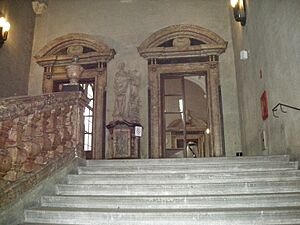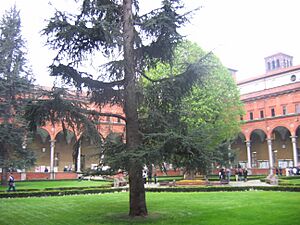Università Cattolica del Sacro Cuore facts for kids

Main entrance of the Milan campus
|
|
| Latin: Universitas Catholica Sacri Cordis Jesu | |
| Motto | Nel cuore della realtà (Italian) |
|---|---|
|
Motto in English
|
In the heart of reality |
| Type | Private |
| Established | 7 December 1921 |
|
Religious affiliation
|
Catholic Church |
|
Academic affiliations
|
IFCU |
| Rector | Elena Beccalli |
|
Administrative staff
|
1,214 |
| Students | 39,593 (2018) |
| Location |
,
Italy
|
| Campus | Urban |
| Newspaper | Vita e pensiero |
| Colors | Blue and gold |
|
Sporting affiliations
|
CUS Milano |
 |
|
Università Cattolica del Sacro Cuore, often called the Catholic University of Milan or just Cattolica, is a private research university in Italy. It was started in 1921. Its main campus is in Milan, Italy. It also has other campuses in Brescia, Piacenza, Cremona, and Rome.
The university has 12 main departments, called faculties, and 7 special postgraduate schools. Cattolica offers different types of courses. These include bachelor's degrees for new students, master's degrees for those who want to study more, and PhD programs for advanced research. The university also has programs where students can get degrees from two different universities. You can study in both Italian and English.
The Agostino Gemelli University Polyclinic is a teaching hospital for the university's medical school. It is named after the university's founder, Agostino Gemelli, who was a Franciscan friar, doctor, and psychologist.
Contents
History of the University
How the Idea Started
The idea for a Catholic university began around 1870. Many Catholic thinkers wanted to create it. In September 1918, as World War I was ending, Giuseppe Toniolo asked Father Agostino Gemelli to make sure the university was built. He said, "I won't see the end of the war, but you, when it's finished, do it, found the Università Cattolica."
Founding and New Departments
In 1919, Father Agostino Gemelli and others created the Istituto Giuseppe Toniolo di Studi Superiori. This institute was officially recognized in 1920. At the same time, Pope Benedict XV approved the university's religious status.
On December 7, 1921, the Università Cattolica del Sacro Cuore officially opened. Father Gemelli led a special Mass. The first campus was small, but in October 1930, it moved to the old St. Ambrose Monastery. This is where the main campus is today. In 1921, only 68 students joined. By 2016, over 30,000 students were studying at its five campuses.
In 1924, the Italian government recognized the university. This meant its degrees were official. New programs in Humanities and Law were started. Over the years, more departments opened. In 1931, the Faculty of Political, Economic, and Social Sciences was created. In 1947, the School of Economics opened. The School of Agricultural Sciences started in Piacenza in 1952.
A Medical School in Rome was a big dream for Father Gemelli. It was approved in 1958. Construction began in 1959. In 1961, Pope John XXIII opened the Medical School. The first doctors graduated in 1967. This school now offers both medical and dentistry programs.
In 1956, the Brescia campus opened. More schools were added in Milan in the 1990s, including Banking, Foreign Languages, and Psychology. In 2000, the university opened 13 Cultural Centres across Italy. These centers offered distance-learning courses using satellite technology. In 2001, the School of Sociology opened in Milan.
In 2012, two new schools were formed by combining existing departments. These were the School of Political and Social Science in Milan and the School of Economics and Law in Piacenza-Cremona.
During World War II
During World War II, a professor named Ezio Franceschini helped the Resistance movement. He held secret meetings at the university. He even hid important documents about the Resistance in the university's basement. The documents were found safely after the war.
The university was partly damaged by bombing in August 1943. Many buildings were hit, including classrooms and a cloister. But reconstruction started right away. Father Agostino Gemelli encouraged everyone, saying the university would "rise again more beautiful and bigger than before."
Student Protests in 1968
In November 1968, students at the university protested because tuition fees were increased. These protests spread across Italy. Students occupied the university, but they were removed by the police. Thousands of students marched in Milan. The university was closed for a while. A student named Mario Capanna was a leader of these protests.
Professors in Government
In November 2011, Italy's Prime Minister, Mario Monti, chose three professors from the university to become government ministers. This showed the high quality of the university's faculty.
University Leadership
The Magnifico Rettore is the top leader of the university. This person is chosen every four years. The Rector represents the university and leads important meetings.
How the University is Organized
Main Departments (Schools)
The university offers many degrees through its 12 main departments, called faculties.
- Faculty of Agricultural, Food and Environmental Sciences, Piacenza-Cremona (started 1951)
- Faculty of Arts and Philosophy (started 1924) ‒ Milan, Brescia
- Faculty of Banking, Finance and Insurance Sciences (started 1990) ‒ Milan
- Faculty of Economics (started 1947) ‒ Milan, Rome
- Faculty of Economics and Law (started 2000) ‒ Piacenza-Cremona
- Faculty of Educational Sciences (started 1936) ‒ Milan, Brescia, Piacenza
- Faculty of Law (started 1924) ‒ Milan
- Faculty of Linguistic Sciences and Foreign Literatures (started 1991) ‒ Milan, Brescia
- Faculty of Mathematics, Physics and Natural Sciences (started 1968) ‒ Brescia
- Faculty of Medicine and Surgery (started 1958) ‒ Rome
- Faculty of Political and Social Sciences (started 1931) ‒ Milan, Brescia
- Faculty of Psychology (started 1999) ‒ Milan, Brescia
Advanced Study Schools
These are special centers for advanced research and teaching.
- ALMED - Postgraduate School of Media Communications and Performing Arts (started 2002) ‒ Milan
- ALTIS - Postgraduate School Business & Society (started 2005) ‒ Milan
- ASA - Postgraduate School of Environmental Studies (started 2008) ‒ Brescia
- ASAG - Postgraduate School of Psychology Agostino Gemelli (started 2001) ‒ Milan
- ASERI - Postgraduate School of Economics and International Relations (started 1995) ‒ Milan
- ALTEMS - Postgraduate School of Health Economics and Management (started 2009) ‒ Rome
- SMEA - Postgraduate School of Agricultural and Food Economics (started 1984) ‒ Cremona
University Campuses
Milan Campus
Cattolica has campuses in six Italian cities. Its main campus is in Milan, located in a historic monastery near the Basilica of Sant'Ambrogio. This monastery was first built by monks in the 8th century. The Milan campus has beautiful architecture, including a chapel, a special entrance called the atrium of the zodiac, and a large main hall.
Many of the university's buildings and facilities are in the St. Ambrose area of Milan. There are also other locations in Milan that house different departments, libraries, and student services.
Other Campuses
The Cattolica also has campuses in other cities.
- The Piacenza campus started in 1953 and houses the Faculty of Agriculture. It also has a large sports center.
- The Cremona campus opened in 1984 and is home to the SMEA school for agricultural and food economics.
- The Rome campus is a large medical campus. It has two faculties, many research centers, and thousands of students. Construction for the medical school and the Agostino Gemelli University Polyclinic began in 1959. Pope John XXIII opened the Medical School in 1961.
- The Brescia campus has four buildings in the city center. It includes classrooms and labs for the Faculty of Mathematical, Physical, and Natural Sciences. New buildings were planned to expand this campus.
- In 1995, Pope John Paul II laid the foundation stone for a research center in Campobasso. This center focuses on biomedical sciences. By 2010, it had over 700 students.
Academics and Learning
Research Activities
The university is very active in research. In 2009, it had nearly 3,000 research projects. Research is done in 22 departments and many research centers. These centers work on important social issues like bioethics and international help.
How to Get In
Most of the university's programs have a limited number of spots. Many require students to pass an admission test to enroll. The admission test for the Medical School is very competitive. For example, in 2017, there were over 8,900 applicants for only 300 spots.
Libraries
The university has a large library system. It works with many national and international groups to provide students with access to books and research materials.
University Rankings and Global Connections
The Cattolica is highly regarded internationally. According to a survey of European universities, it is one of the most recommended universities by foreign students.
In the QS World University Rankings 2025, Cattolica is ranked 442nd overall. It is also ranked among the top universities for specific subjects like law, economics, and agriculture. The university is part of many international networks. It has exchange programs and dual degree programs with universities around the world, including in London, Boston, and Paris.
EDUCatt Services
EDUCatt is a special foundation at Cattolica University. It helps students with many things, such as financial aid, housing, food services, health care, and psychological support. It also helps create study books for students.
University Media
The university has its own publishing house called Vita e pensiero, which started in 1918.
It also publishes several magazines:
- Vita e pensiero is the official university magazine.
- Presenza shares news and current affairs about the university's campuses.
- Comunicare is a magazine for the Medical School in Rome.
Youcatt is the university's web TV channel. It started in 2009 and covers university events and student experiences. It won an award in 2011 for being the best Italian web TV. Students also run their own media, like Radio Catt and TV Catt, which started in 2012.
Student Life
Places to Live (Residential Colleges)
There are several colleges on or near the university campuses where students can live. These include Augustinianum College and Marianum College in Milan, and San Damiano College in Rome.
Code of Conduct

In 2011, the university introduced a code of ethics. This document lists the values and rules of behavior for everyone at the university. Students must agree to follow this code when they enroll. It promotes values like honesty, fairness, and respect for others.
Student Groups
Many student groups exist across the university's campuses. They organize cultural activities and publish magazines. Some groups also work on social issues.
Online Services
I-Catt is an online portal for students. It provides information about classes, exam schedules, and teacher announcements. The university also uses Blackboard Inc. for online learning materials. Computer labs and Wi-Fi are available on all campuses.
Sports Activities
The university has a sports center in Milan where many sports activities take place. The university teams have won several championships. In 2009, the university hosted the IFIUS World Interuniversity Games.
University Traditions
On the Milan campus, there is a special garden called the Garden of St. Catherine of Alexandria. It is only open to female students, which is why it is sometimes called "The Virgins' Garden."
In May, there is a tradition where older students playfully throw buckets of water at new students. This is called "nicchiato" and has been happening for many years. Another tradition in the university colleges is "processes" evenings, which help students get to know each other better.
Alumni Association
The Alumni Cattolica Ludovico Necchi Association was founded in Milan in 1930. It includes all graduates from the university. Each year, the association gives out the Agostino Gemelli award to the best student from each school.
Famous People from Cattolica
Many notable people have studied or taught at Università Cattolica. These include:
- Italian political leaders like Oscar Luigi Scalfaro and Romano Prodi.
- Italy's first woman cabinet minister, Tina Anselmi.
- The former Governor General of Canada, Michaëlle Jean.
- The founder of the ENI energy company, Enrico Mattei.
- Fashion designer Nicola Trussardi.
- Singer Roberto Vecchioni.
- Gymnast Igor Cassina.
- Internet entrepreneur Augusto Marietti.
Famous faculty members include banker Giovanni Bazoli, archaeologist Valerio Massimo Manfredi, and the founder of Communion and Liberation, Luigi Giussani.
See also
 In Spanish: Universidad Católica del Sagrado Corazón para niños
In Spanish: Universidad Católica del Sagrado Corazón para niños
- List of Italian universities
- List of modern universities in Europe (1801–1945)
- Agostino Gemelli
- Cloisters of Sant'Ambrogio



